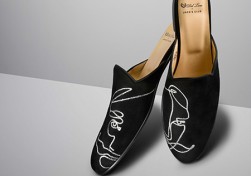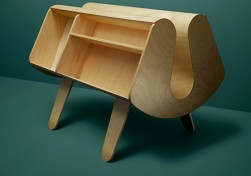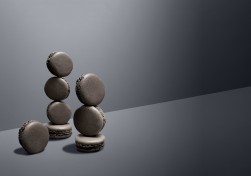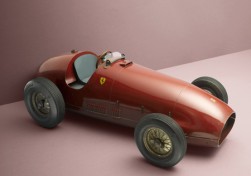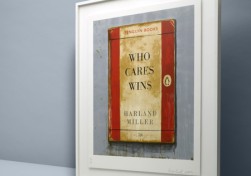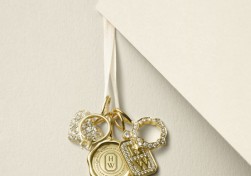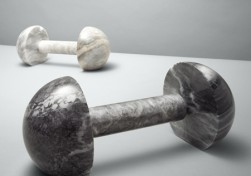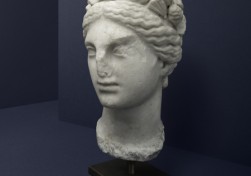Originally designed as a house shoe for Victorian men hosting formal dinners, or to wear with a silk dressing gown for elegant evenings chez soi, the dress slipper is enjoying a remarkable revival among fashionable men. Almost 200 years after Queen Victoria’s husband, Prince Albert, elevated it from a practical, mud-free indoor shoe to a piece of footwear fashioned from velvet and lined with quilting, it has made its way from palaces and mansions to the catwalks of Ralph Lauren and Dolce & Gabbana. Although Hollywood stars such as Clark Gable teamed their black slippers with tuxedos, today the shoes are just as likely to be worn with jeans. Some stylists are going so far as to suggest that the slipper is the ultimate shoe for all times of day, worn with a white t-shirt and jeans for casual occasions and a navy polka-dot tie and shirt square for a business-casual look. For those who fall in love with the style, there are models for all seasons, from navy blue suede to a dashing red velvet. The slipper pictured here was created for Jack’s Club, a series of St. Regis pop-ups in honor of John Jacob “Jack” Astor IV, the founder of St. Regis. For those who want something a little more rock ’n’ roll, shoemaker GJ Cleverley even offers to embroider a skull and crossbones on its velvet shoes. Unusual? Yes. But then, if you are going to leave the house in slippers, as Esquire magazine’s Jonathan Evans puts it, “You want to feel a little bit louche, and yes, a bit rakish. Isn’t that the point?”
Category Archive: 7 objects
We live in an era in which the savvy CEO is more likely to turn up at a board meeting on a bicycle than in a chauffeur-driven limo. The bike, after all, projects agility and all the fresh, un-starchy energy of a start-up. And folding bikes are emerging as a particularly popular way to get about, especially for commuters. They’re not as cumbersome as regular bikes; most train companies let you board with one, folded up; and they’re small enough to tuck under a desk at work. The problem with most folding bikes, until now, has been the time they take to unfold (several minutes) and their weight (mostly between 20 lbs and 40 lbs). In the past year, however, buoyed by the popularity of bicycles in big cities, several manufacturers have put their minds to creating the perfect commuting bike. Which is what? According to online magazine cyclingweekly.com, a bicycle with tires between 1.7 and 2 inches wide, which grip the road well; internal hub gears, which cut down on maintenance; good brakes and easy-to-fold parts. The new Hummingbird (photographed here) ticks all the boxes. Launched via Kickstarter, and available since May 2017, this is the lightest folding bike on earth, at 16.5 lbs. Made of carbon fiber, it was manufactured using techniques created for professional motorsport – this is a bike that its designers can justifiably claim is made to Formula 1 standards. Its folding mechanisms allow it to be unfolded in five seconds, its Hummlock “safety pin” keeps it all together, its four-speed gears allow it to be ridden on varied terrains and its Tektro brakes are powerful enough to stop quickly in a city. The only extras one might ask for are mudguards and a carbon belt drive – but those, Hummingbird says, are in the pipeline. We didn’t ask about a bell. hummingbirdbike.com
A clever composite made of layers of fine wood glued together, plywood has been used since Egyptian times. Although its easy-to-mold forms were widely put to use in the early 20th century to make boats, furniture, houses and even planes – such as Amelia Earhart’s famous trans-Atlantic Lockheed Vega 5B – it was only after World War II that experimental furniture designers such as Charles and Ray Eames and Alvar and Aino Aalto recognized that in plywood they had a material that, when it was steamed, could be molded into curvaceous shapes. By the 1950s, Eames chairs, with their molded plywood seats, had become synonymous with midcentury modernism and the Aaltos’ curvaceous walls had changed public perceptions of plywood in architecture. Today, our love affair with plywood has been reignited, as designers once again appreciate the beautiful forms, from skateboards to chandeliers, that can be made from this most humble of materials. Product designers such as Lozi have started to create elegant plywood pieces for the home, from lamps to planters, and furniture-makers such as Branca Lisboa have taken inspiration from natural shapes such as sea-shells to construct super-modern seats created with “bones” of steamed ply. It’s even being used to create the curvaceous walls of cutting-edge stands at art shows such as Art Basel, Miami. Why the return to fashion? Not only does plywood’s simple honesty fit well with the pared-back aesthetic of the 21st century, but the marriage of form and function in such sculptural pieces as the 1939 Isokon Penguin Donkey bookshelf (pictured here) is irresistible to those living in small homes – even to aesthetes who might never before have considered buying a mass-produced, inexpensive veneered composite. isokonplus.com
The medicinal properties of charcoal have long been known: both Hippocrates (in 400 BC) and Pliny the Elder (in AD 50) described it being used to treat ailments from rotting wounds to vertigo. What the savants might never have predicted, though, is the sudden popularity of burnt vegetable matter in the food scene of the 21st century. Venture into hip restaurants from Shanghai to Houston and there’s sure to be a dish into which charcoal has been added – whether it’s a smoothie, a macaroon, (like those pictured left), or a kuro burger – which, if you aren’t familiar with the Japanese dish, comprises a blackened bun, a meat patty, a sliver of black cheese and black squid-ink sauce. It’s even making its way into water jugs – single pieces of blackened matter inserted into the bottom to help purify their contents. According to supplier Mark Parr, who provides chefs with charcoal both to cook with and to cook over, the type of plant matter from which it’s made can significantly alter the flavor. Alder charcoal imparts a sugary sweetness, he says, while oak’s heavily flavored smoke is perfect for cooking and smoking salmon. The bad news? Although charcoal is often prescribed as a medication in hospitals – the porous substance isn’t processed by the stomach, but can soak up poisons and toxins while passing through the body – it has little benefit to health when eaten in small quantities. “Activated charcoal, which is found in water filters to remove impurities, is an effective internal cleanser in quantity,” says nutritionist Angela Dowden. “But in the tiny amount you find in foods? Unlikely.” Never mind. The fashionably dark dishes look wonderfully dramatic, and can garner thousands more likes for us on Instagram. That in itself can make us feel a whole lot better.
You could probably buy a brand new car for the price of a replica classic these days. But that’s not the point. The beauty we have photographed here, from Bentleys London, is a model of a 1950s Ferrari F500 F2: a vehicle that took nine Grand Prix victories and became one of the best-loved cars of all time. The popularity of model cars at collectors’ emporiums and auction houses partially explains the growth in the market for motoring memorabilia in general, from model cars and helmets to driving gloves and watches. When Christie’s Geneva auctioned a collection of Rolex Daytona Cosmograph wristwatches, designed specifically for racing drivers, all 50 watches were sold for a combined total of more than $13 million. The star of the show – a unique model known as the Paul Newman, because the racing-fanatic actor always wore one – fetched over a million dollars, more than four times the expected price. According to Bonhams, the trend extends to old car-sale and promotional books from the Golden Age of motoring, which are achieving impressive prices. Even some rare Scalextric slot cars can reach well over $1,000 apiece. Why? It’s a great way for a car enthusiast to collect, without having to garage a big vehicle. Although, as motoring author Giles Chapman says, what real collectors want to amass is memorabilia from luxury marques such as Aston Martin, Rolls-Royce, Bugatti and Bentley. “It really has to be something connected with a good marque,” he says, explaining that a Spirit of Ecstasy from the hood of a Rolls-Royce will always find a buyer. “No one,” he adds, “is interested in a model Hyundai or Seat.” bentleyslondon.com
In the past, the art print was considered a lesser commodity to the original artwork, often secreted in a portfolio, or hung en masse on a passageway wall. But recently the print has returned to favor. Why? Not simply because prints are less expensive and more accessible than an original (who can find an original Matisse painting these days to buy, even if one had the tens of millions to acquire it?) Or because, with the rise of online galleries which have grown web-based art trade to around $2 billion a year, it’s now much simpler to find an original work of art and get it delivered to your home as quickly as your groceries. It’s also because prints, like this one from Hang-Up Gallery, have lost their lesser status. Indeed, since the contemporary art market began to soar in the 1980s, a slew of galleries have started up to offer prints from household-name artists at relatively low prices. “It’s a comfortable entry point for people who haven’t necessarily bought art before,” says James Booth-Clibborn, whose company, Manifold Editions, specializes in contemporary artists. He explains that prints are offered in limited edition, averaging fewer than 70, each signed and numbered by the artist. “Prints are an affordable way to collect works by leading contemporary artists. You won’t need a fortune to start your collection.” There may be another factor contributing to the upward trajectory of these once-derided artifacts. As contemporary art moves into the large-scale installation, video and floor-based sculpture, the small scale of the old medium brings art back to that most popular of all spaces: the domestic wall. manifoldeditions.com, hanguppictures.com
Until now, the scent of a violet has been thought of as, well, a little old-fashioned and prim. But, like many perfumes beloved by Victorian ladies, the fragrance of this most velvet of flowers is muscling its way back into fashion and scenting the smartest spaces once again. Violets are part of the scent of the St. Regis “Caroline’s Four Hundred Candle”, made by Carlos Huber of the perfumer Arquiste, in homage to the glory days of Caroline Astor, the matriarch of the original St. Regis hotel’s founding family, who hosted some of the most glorious parties New York has ever seen. “The violets in this scent formula would have been the same as the ones Mrs Astor would use as centerpieces in the St. Regis ballroom in the Gilded Age,” says Huber. Why is the flower such an olfactory hit? “The scent is intriguing,” says Huber. “It comes and goes. One minute you smell it, and the next it’s gone. This chemical characteristic makes them attractive and ever-new.” Oils extracted for perfume come from the Viola Odorata, also called the Sweet Violet, which grows in the Mediterranean region and Asia Minor and produces delicate purple, white or variegated flowers that appear in early spring. The scent itself comes from ionones in the plant, which create its trademark sweetness and powdery, woody-floral characteristics that have been popular for centuries. The French Emperor Napoleon was a lover of violets (they are thought to have therapeutic properties, and help to ward off colds, asthma, rheumatic pains and infections) as was his Empress, Josephine, who wore them on her wedding day. And it’s safe to say there was nothing prim about them.
No one can dislike a charm. Based on a simple talisman hung on a piece of string, it’s one of world’s oldest jewelry styles. While originally charms were carved out of a gem, rock, horn or wood, and worn to ward off evil spirits, in Victorian times, they became more decorative: fashioned from silver or gold and chosen to signify important things in the wearer’s life, from christenings to engagements. When Queen Victoria herself took to wearing clusters of them – some with lockets of hair, others with miniature portraits – the fashion world was quick to embrace them. Soon Chanel and Tiffany (with its iconic Tiffany heart) became renowned for stylish versions, followed subsequently by designers and brands around the globe, from Vivienne Westwood to Chloé, Alison Lou, Jennifer Meyer and Harry Winston (pictured). This time, though, as well as the traditional Cinderella coaches, dogs and ponies clinking on wrists, there are 21st-century motifs, from lightning bolts and skulls to smiling emojis and arrows, worn in clusters on necklaces by fashionable young women. Why the sudden resurgence in popularity? Not only because this boho prop has “passage of life”significance – equally appreciated by both a child and a fashionable woman for a special occasion – but because it’s versatile. Single charms can be worn with a pretty dress or you can bring out your inner Esmeralda with a clinking bunch of them. This season, a bit of wizardry has also been added to the mix: Harry Potter charms that bring not just literary characters to the frame, but a little bit of 21st-century magic too. harrywinston.com
In the fickle world of fitness there’s been a move away from unsightly and complicated high-tech products towards those that are simple and rather beautiful: excellent news for anyone who likes their workout space to be as beautiful as their home. Following on from other such handsome fitness items as cast-iron kettle bells, Indian clubs and Persian “Shena” push-up boards comes a range of new designer dumbbells so beautiful, they could be mistaken for domestic sculpture. Pent, for example, makes bespoke dumbbells from European walnut with steel and brass inlay – a finely tooled look that (hopefully) complements your rippling abdomen – as well as a range of barbells, called the Lesna, with removable weights that are as handsome as contemporary artworks. (Rather wonderfully, they can be engraved, so everyone knows they’re yours.) The German company Hock Design has created a limited-edition run of 50 sets of dumbbells made from 18-carat gold and rare grenadilla wood, which could be used as doorstops should your quest for the perfect body fizzle out. And the Swedish company Tingest makes marble dumbbells (pictured) in either black or white, as well as kettlebells, which they launched at the Stockholm furniture fair, that resemble exquisite handbags and could sit as happily in a feminine room as they could in a macho gym. These weights don’t just sit incognito while not in use, but declare themselves proudly. And just perhaps, your body will follow their example. pentfitness.com; hockdesign.com; tingest.com
Antiquities that have long gathered dust in museums are at last coming out of hiding and finding new homes in contemporary spaces around the globe. For those fed up with what they believe is the shallowness of contemporary art, the arrival of ancient sculpture in the domestic interior is a welcome relief. Busts are not just visually beautiful – extraordinary examples of master craftsmanship – but a visual dive into deep history. This beautiful 2nd-century white crystalline marble bust of a woman’s head, for instance, from Kallos Gallery, is a depiction of Ariadne, who became the bride of Bacchus, the god of wine. It would have adorned the home of a wealthy Roman, who appreciated not just luxury materials, but the craftsmanship: the wreath here is made of finely carved pine cones and clusters, each finely modeled and hand-drilled. Heads such as this are also becoming extremely valuable at market. In 2010 a Roman marble portrait bust sold at Sotheby’s New York for $23.8 million – ten times the expected $2 million – and in 2014, an Egyptian limestone statue sold for over $20m at Christie’s: almost five times what they expected. Today, dealers and galleries such as Ariadne Galleries, David Ghezelbash, Phoenix Ancient Art, and Gordian Weber Kunsthandel feed an increasingly hungry group of collectors. The current trend is to mix antiquities with modern pieces, in the style of the Belgian seer of modern collecting, Axel Vervoordt. The trick if you get one? Backlight it, says Vervoordt. “That really brings an ancient head to life.” kallosgallery.com
